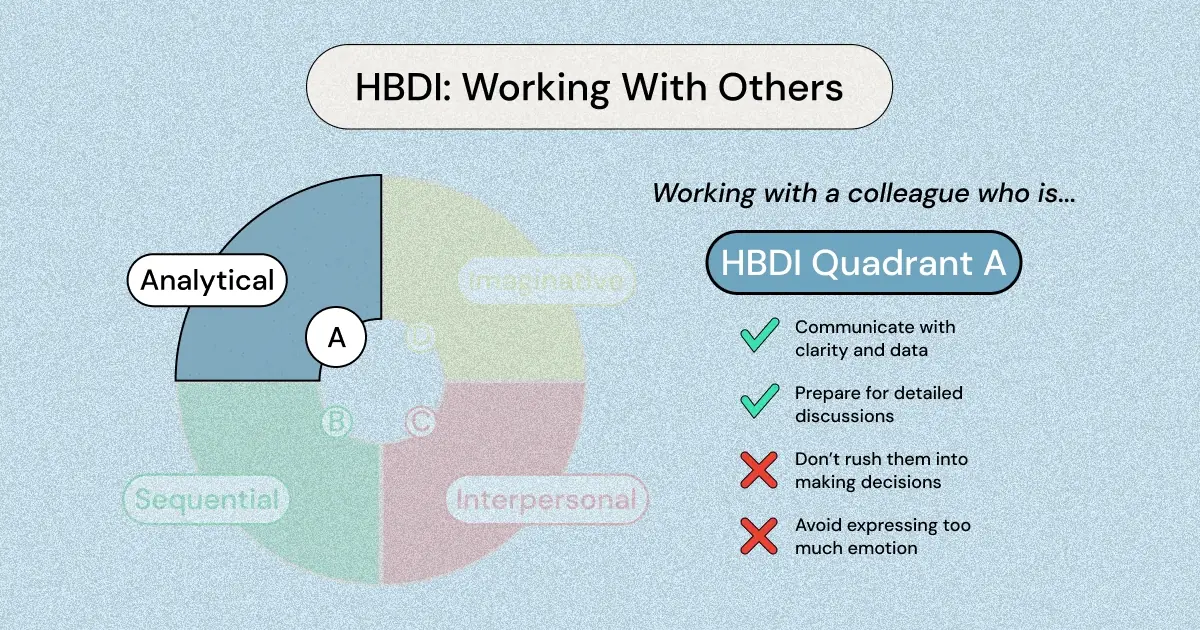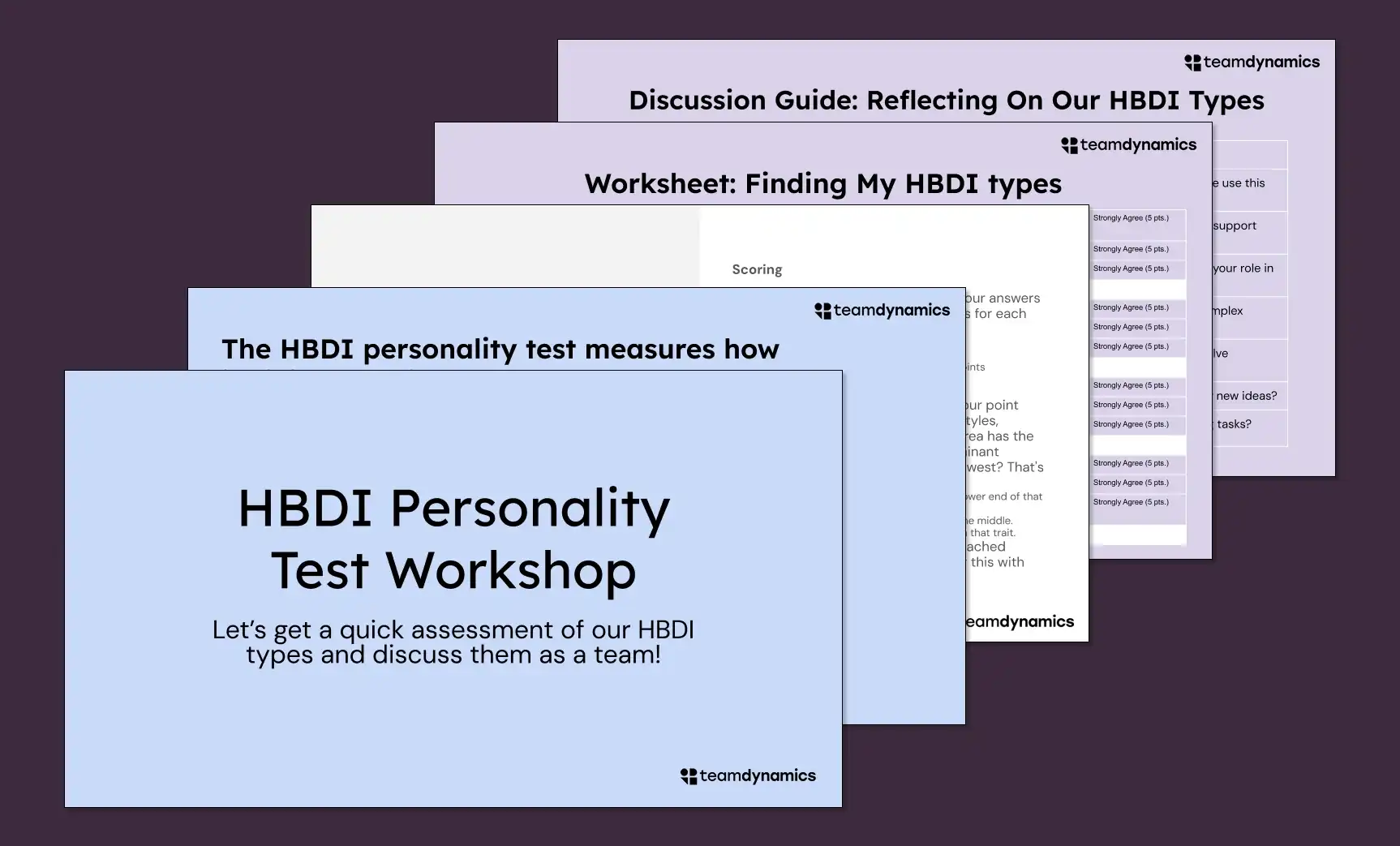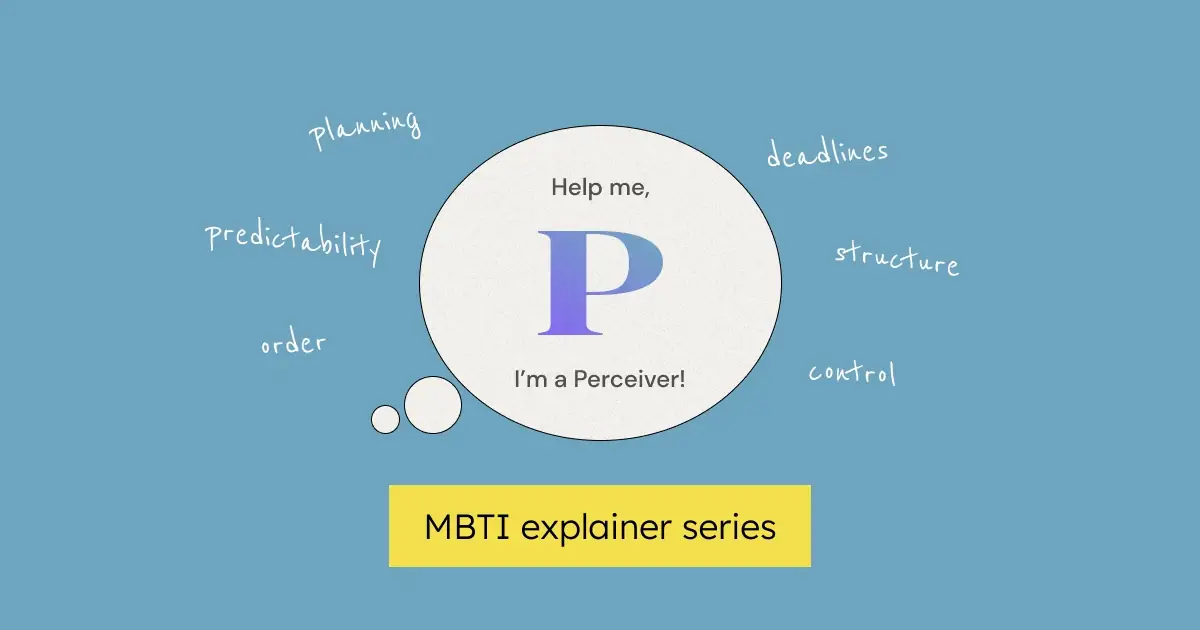Welcome to the intricate world of working with HBDI Quadrant A (Analytical) colleagues. In the diverse landscape of professional settings, understanding and adapting to different cognitive styles is not just beneficial; it’s essential for collaborative success. If you've ever worked with someone who thrives on facts, data, and logical reasoning, you've experienced the unique approach of an Analytical thinker. But how exactly do you navigate and make the most of this relationship in a work environment?
The Herrmann Brain Dominance Instrument (HBDI) categorizes thinking preferences into four quadrants, with Quadrant A focusing on Analytical thinking. Individuals strong in this quadrant are often methodical, data-driven, and objective. They excel in logical problem-solving and are adept at analyzing situations to make fact-based decisions. However, working effectively with someone who predominantly exhibits these traits can require a nuanced understanding and strategic approach.
Are you looking for a tool to help you understand how your team works and improve its performance? Consider trying TeamDynamics, the personality test for modern teams.
In this comprehensive guide, we’ll delve into the nuances of collaborating with an Analytical (HBDI Quadrant A) colleague. We’ll uncover the key characteristics that define their thinking style and provide you with actionable strategies to communicate, collaborate, and drive mutual success. Whether you’re looking to enhance project collaboration, improve communication, or simply gain a better understanding of your Analytical colleagues, this blog post will equip you with the knowledge and tools you need.
Get ready to unlock the secrets of successful collaboration with Analytical thinkers in your workplace, and turn your professional interactions into opportunities for growth and productivity!
Looking for the most popular alternatives to HBDI? Check out the 5 best alternatives to HBDI.
Recognizing the Strengths of an Analytical Thinker
When you're collaborating with a colleague who excels in the HBDI Quadrant A, you're working with someone who brings a unique and powerful set of skills to the table. Understanding and appreciating these strengths is the first step to creating a harmonious and productive working relationship. Let's explore what makes Analytical thinkers stand out and how their qualities can be a tremendous asset in the workplace.
The Essence of Analytical Thinking:
- Masters of Logic and Data: Analytical thinkers are characterized by their logical, data-driven approach to problem-solving. They are adept at dissecting complex information, identifying patterns, and focusing on facts to come to conclusions. This precision and objectivity make them invaluable in situations that require thorough analysis and fact-based decision-making.
- Detail-Oriented and Methodical: Their methodical approach means they excel in areas that require meticulous attention to detail. Whether it's data analysis, financial forecasting, or strategic planning, you can count on an Analytical thinker to dive deep into the specifics and ensure accuracy in every aspect.
The Strengths of Logical Problem-Solving:
- Objective Decision Making: One of the standout strengths of Analytical thinkers is their ability to make decisions based on objective data rather than subjective opinions. This trait is especially crucial in high-stakes environments where clarity and precision are paramount.
- Efficiency in Processes: Thanks to their structured way of thinking, Analytical colleagues often excel in creating and optimizing efficient processes. They can break down large projects into manageable steps, ensuring that each phase is logically planned and executed.
Understanding the characteristics of HBDI Quadrant A thinkers allows you to better align your collaborative efforts, ensuring that you leverage their strengths for mutual success. By valuing their logical insights and methodical approach, you can create a work environment that not only respects diverse thinking styles but also thrives on them.
{{inline-cta}}
Effective Communication Strategies
Communicating effectively with a colleague who excels in HBDI Quadrant A (Analytical) requires an understanding of their logical, data-focused approach. To foster a productive and harmonious working relationship, it's crucial to adapt your communication style to meet their preferences. Here are some strategies to ensure that your interactions with Analytical thinkers are both effective and impactful.
Clarity and Precision in Communication:
- Convey Information with Directness: Analytical thinkers appreciate direct and to-the-point communication. When discussing projects or ideas, be clear and concise. Avoid ambiguity and get straight to the facts. This straightforward approach aligns with their preference for clarity and efficiency.
- Use Data to Support Your Points: Given their inclination for data, back up your arguments or proposals with solid evidence. When you present information supported by data, it resonates more with Analytical colleagues, as it aligns with their logical approach to processing information.
Data-Oriented Discussions:
- Focus on Facts and Details: When engaging in discussions, focus on the facts and specific details. Analytical thinkers tend to be less influenced by emotional appeals and more by logical arguments and empirical evidence.
- Prepare for In-Depth Analysis: Be prepared for in-depth discussions. Analytical colleagues often delve deeply into topics, analyzing every angle. Ensure you understand the finer details of the subject at hand to engage effectively in these discussions.
Respecting Their Analytical Process:
- Allow Time for Processing: Understand that Analytical thinkers may need time to process information and come to conclusions. Be patient and give them the space to think things through. Rushing decisions or expecting immediate answers can be counterproductive.
- Encouraging Questions and Exploration: Be open to questions and detailed exploration. Analytical colleagues often ask probing questions to understand all aspects of an issue. Encourage this curiosity as it leads to more thorough and well-considered outcomes.
By employing these communication strategies, you can build a stronger rapport with your Analytical colleagues. Effective communication that respects their logical, data-driven approach can lead to more productive collaborations and better mutual understanding in the workplace.
Collaborating on Projects and Decision Making
Working alongside a colleague who excels in HBDI Quadrant A (Analytical) can significantly enhance the quality of your projects and decision-making processes. Their logical, structured approach to problem-solving can be a key asset in any team. Here's how you can effectively collaborate with an Analytical thinker to achieve the best outcomes in your joint endeavors.
Leveraging Analytical Strengths in Team Projects:
- Capitalizing on Their Problem-Solving Skills: When tackling complex projects, involve your Analytical colleague in the problem-solving stages. Their ability to dissect problems and analyze data can uncover insights that might otherwise be missed.
- Incorporating Their Input for Detailed Planning: Utilize their penchant for details in the planning phase. Analytical thinkers can help create comprehensive project plans that consider all variables and potential roadblocks, ensuring a smoother execution.
Enhancing Team Decision-Making Processes:
- Data-Driven Decisions: In team meetings, encourage your Analytical colleague to share their data-driven perspectives. Their fact-based approach to decision-making can ground discussions and help the team make informed choices.
- Balancing Perspectives: While valuing their analytical insights, also encourage a balance of perspectives. Combine their logical approach with creative and interpersonal viewpoints from other team members for well-rounded decisions.
Creating Synergy with Diverse Thinking Styles:
- Fostering a Collaborative Environment: Promote an environment where different thinking styles are valued. When Analytical thinkers feel their approach is respected, they are more likely to engage actively and collaborate effectively.
- Bridging Communication Gaps: Sometimes, the logical approach of Analytical thinkers might contrast with the more intuitive styles of other team members. Play a role in bridging these communication gaps by translating ideas and ensuring mutual understanding.
By understanding and leveraging the strengths of an HBDI Quadrant A colleague, you can enhance not only the quality of your work but also the efficiency of your team's processes. Their analytical mindset, when combined with other cognitive styles, can lead to innovative, well-thought-out solutions and decisions.
Balancing Analytical and Emotional Perspectives
In a professional setting, the harmony between analytical logic and emotional intelligence is pivotal for a well-rounded team dynamic. Working with a colleague who is dominant in the HBDI Quadrant A (Analytical) offers a unique opportunity to blend these perspectives. Here's how you can effectively integrate the precision of analytical thinking with the empathy of emotional perspectives in your collaborative efforts.
Integrating Diverse Cognitive Styles:
- Valuing Different Viewpoints: Recognize the importance of both analytical and emotional inputs in decision-making and problem-solving. While your Analytical colleague may focus on data and logic, complementing their approach with emotional and creative insights can lead to more comprehensive solutions.
- Encouraging Emotional Intelligence: Foster an environment where emotional intelligence is valued alongside analytical thinking. This can involve recognizing the impact of team morale on productivity or considering the emotional aspects of business decisions.
Achieving a Balanced Approach in Teamwork:
- Leveraging Analytical Strengths: Utilize your colleague's analytical skills for tasks that require precision and logical structuring, such as data analysis or strategic planning. Their methodical approach can provide clarity and direction in these areas.
- Incorporating Emotional Insights: At the same time, ensure that the human element isn’t overlooked. Bring emotional insights into discussions, especially when dealing with team dynamics, client relations, or brainstorming sessions. This balance ensures decisions are both data-informed and empathetically guided.
Navigating Emotional and Logical Challenges:
- Addressing Misunderstandings: Miscommunications can arise from differing approaches. If your analytical colleague tends to focus solely on data, bridge the gap by clearly explaining the emotional rationale behind certain decisions or ideas.
- Combining Data with Storytelling: To make data more relatable, combine analytical reports with storytelling techniques. This approach can help in presenting data in a way that resonates on an emotional level, making it more impactful and understandable for the entire team.
By embracing both analytical logic and emotional intelligence, you can create a more dynamic and effective team environment. This holistic approach ensures that decisions are well-informed, empathetic, and reflective of a diverse range of perspectives.
Navigating Challenges and Misunderstandings
Working with a colleague who is strong in the HBDI Quadrant A (Analytical) can be incredibly rewarding, yet it may also present specific challenges, particularly when it comes to communication and approach to work. Understanding how to navigate these challenges is key to maintaining a productive and harmonious working relationship. Here are some strategies for effectively working alongside your analytical colleagues and overcoming potential hurdles.
Overcoming Communication Barriers:
- Adapting to Different Communication Styles: Recognize that analytical thinkers often prefer direct and data-focused communication. If you tend to be more narrative or emotion-driven in your approach, find a middle ground where your styles can meet. This might involve backing up your points with data or focusing on the logical flow of your arguments.
- Clarifying and Confirming Understanding: Misunderstandings can arise from differences in communication styles. Ensure clarity by summarizing key points and asking for confirmation of understanding. This practice helps prevent miscommunication and ensures that all parties are on the same page.
Addressing Differences in Problem-Solving Approaches:
- Respecting Their Analytical Process: Analytical thinkers often require time to process information and may not respond well to being rushed. Respect their need for analysis and give them space to work through problems in their preferred way.
- Bridging the Gap with Empathy: While your analytical colleague may focus on data, it's important to also consider the emotional and human elements of a situation. Gently introduce these aspects into discussions, helping them see the broader context beyond the data.
Adapting to Diverse Work Styles:
- Embracing Various Approaches to Work: Acknowledge that different people have different ways of approaching tasks and making decisions. While your analytical colleague might prefer a structured and methodical approach, others might rely more on intuition or spontaneity. Embrace these differences as a strength rather than a barrier.
- Finding Common Ground in Goals: Despite different working styles, remember that you and your analytical colleague likely share common goals. Focus on these shared objectives to build a sense of teamwork and collaboration.
By understanding and adapting to the challenges that come with working alongside someone strong in analytical thinking, you can create a more cohesive and productive working environment. Embracing diverse perspectives not only enhances team dynamics but also leads to more well-rounded and effective solutions.
Personal Growth and Mutual Benefits
Engaging with a colleague who excels in the HBDI Quadrant A (Analytical) not only contributes to a dynamic and efficient work environment but also presents a unique opportunity for personal and professional growth. In this section, we delve into how building a productive working relationship with an analytical thinker can enhance your skills and lead to mutual benefits for both parties.
Enhancing Your Own Skills Through Collaboration:
- Learning from Their Analytical Approach: Working closely with an analytical thinker can sharpen your own problem-solving skills. Observe how they dissect complex issues and use data to inform decisions. Incorporating some of these strategies into your approach can enhance your analytical thinking.
- Developing a Data-Driven Mindset: Exposure to their data-driven approach can inspire you to consider the importance of data in your work. This shift in perspective can be particularly beneficial in today’s data-centric world, helping you make more informed and objective decisions.
Mutual Growth Through Diverse Perspectives:
- Combining Strengths for Better Outcomes: Collaborating with someone who has a different cognitive style allows for a combination of strengths. Your colleague’s analytical prowess, coupled with your potentially more creative or interpersonal approach, can lead to well-rounded and innovative solutions.
- Expanding Problem-Solving Capabilities: By learning from each other, you both can expand your problem-solving toolkits. While they may introduce you to new methods of logical analysis, you can offer insights into creative thinking or emotional intelligence, enriching the collaborative process.
Building a Culture of Learning and Adaptability:
- Fostering a Learning Environment: Encourage a team culture where learning from each other is valued. This environment not only enhances individual skills but also strengthens the team as a whole.
- Adapting to Different Work Styles: Working with an analytical colleague can improve your adaptability. Learning to adjust your communication and work style to complement theirs can make you more versatile and effective in diverse professional scenarios.
Engaging and collaborating effectively with an HBDI Quadrant A colleague offers a path to enhancing your own skill set while contributing to their growth. This symbiotic relationship fosters a dynamic work environment where diverse thinking styles are not just acknowledged but leveraged for mutual success.
Conclusion and Summary
As we wrap up our exploration of how to successfully work with a colleague who is dominant in the HBDI Quadrant A (Analytical), it’s clear that understanding and adapting to different cognitive styles is crucial in today’s diverse and dynamic professional world. The insights and strategies we've discussed are not just tools for effective collaboration but also gateways to broader professional development and workplace harmony. Let’s recap the essential takeaways from our discussion.
- Embracing the Strengths of Analytical Thinking: Recognize and appreciate the value that an analytical colleague brings to the table. Their logical, data-driven approach to problem-solving and decision-making can significantly enhance the quality and precision of your team’s work.
- Effective Communication and Collaboration: Tailor your communication style to be clear, direct, and data-oriented when interacting with analytical thinkers. This ensures that your ideas resonate with them and fosters a more productive exchange of thoughts and information.
- Integrating Diverse Perspectives for Enhanced Problem-Solving: Embrace the diverse cognitive styles within your team, including the analytical perspective. Combining different approaches, such as creative, emotional, and structured thinking, can lead to more innovative and comprehensive solutions.
- Adapting to and Learning from Each Other: View your collaboration with analytical thinkers as an opportunity for personal and professional growth. Learning from their approach can sharpen your own analytical skills, while sharing your strengths can contribute to their development.
- Fostering a Culture of Mutual Respect and Learning: Promote an environment where different thinking styles are not just acknowledged but valued. This culture of mutual respect and continuous learning is key to building a cohesive and adaptable team.
Working effectively with an HBDI Quadrant A colleague is about more than just achieving immediate project goals; it's about building a foundation for long-term success and mutual growth. By understanding and leveraging the strengths of analytical thinking, while also bringing in your unique perspectives, you can create a balanced and dynamic work environment.




.png)





































